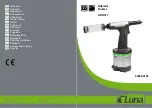
Greenlee / A Textron Company
5
4455 Boeing Dr. • Rockford, IL 61109-2988 USA • 815-397-7070
1800 Mechanical Bender
Illustrated Bending Glossary
1.
back-to-back bend
— any U-shaped bend formed by
two parallel 90° bends with a straight section of conduit
or pipe between the bends.
2.
center-to-center distance
— the distance between the
successive bends that make up an offset or a three-bend
saddle.
3.
developed length
— the actual length of pipe that will
be bent; refer to distance “d” in the illustration at left.
4.
gain
— the difference between the straight-line distance
(a + a) and the shorter radial distance, (d) where:
q
= angle of bend
r = the centerline bending radius of the bending shoe
5.
kick
— single bend of less than 90°
6.
leg length
— the distance from the end of a straight
section of conduit or pipe to the bend; measured from
the end to the outside edge of the conduit or pipe.
7.
offset bend
— two opposite bends with the same
degree of bend; used to avoid an obstruction.
8.
offset height
— the distance between the two legs of
an offset bend, measured perpendicular to the two legs;
also called amount of offset and depth of offset.
9.
rise
— the distance from the end of a straight section of
conduit or pipe to the bend; measured from the end to
the center line of the conduit or pipe. Also called stub or
stub-up.
10.
saddle
— a three-bend or four-bend combination; used
to avoid an obstruction.
11.
shrink
— the amount of conduit “lost” when laying out
an offset bend working toward an obstruction.
12.
springback
— the amount, measured in degrees, that a
conduit or pipe tends to straighten after being bent.
a
a
d
r
Offset Height
































